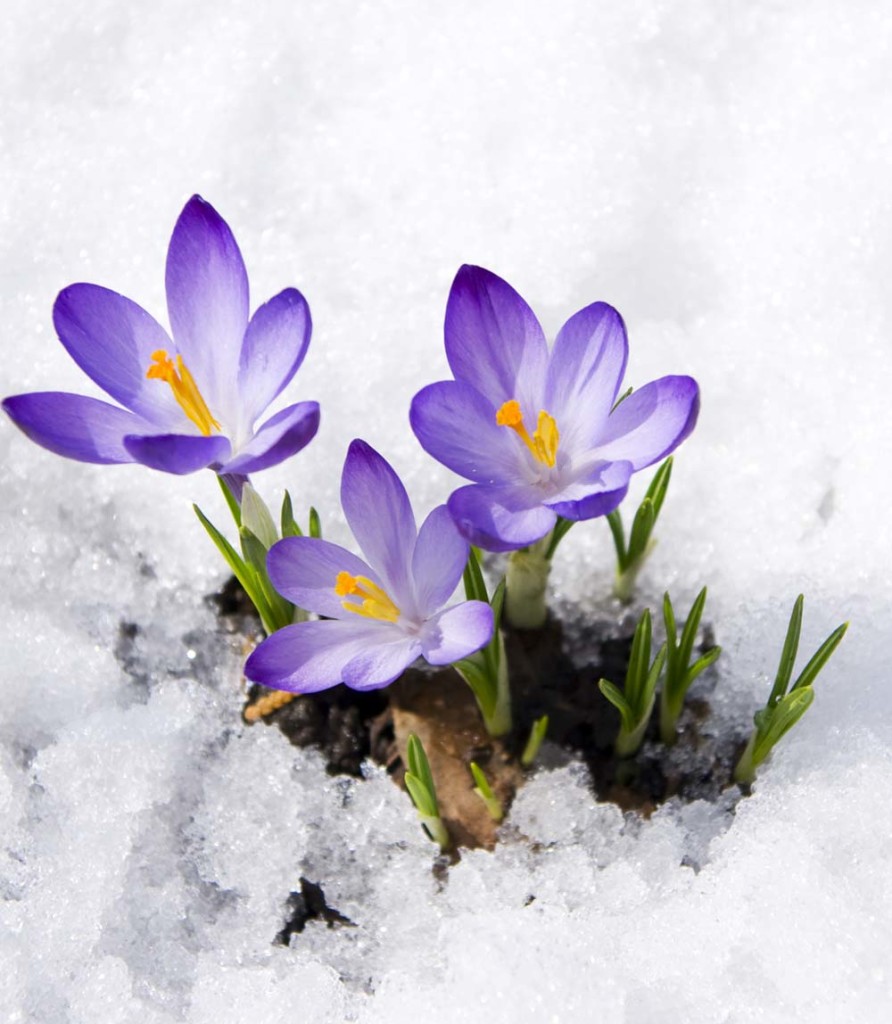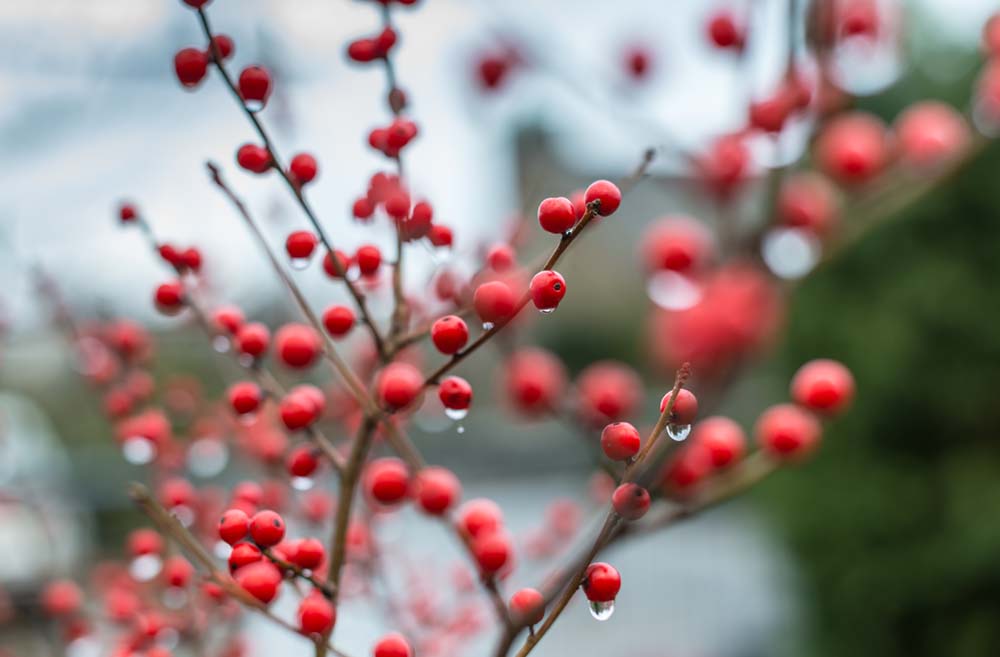Wish you could keep your garden in winter? You may be surprised to learn that it’s possible in warm and cold climates alike. Get ready to treat your bleak landscape as a blank canvas for a serene winter wonderland.
Winter-blooming bulbs

Cheery crocus blooms announce that spring is not far away.
A garden just isn't complete without a few surprises, and finding white snowdrops (Galanthus nivalis, zones 3-8) or the radiant blooms of crocus (Crocus biflorus, zones 3-8b) peeking through the snow is quite a discovery indeed.
You'd normally expect to see irises in spring, but the midwinter blooms of Algerian winter iris (Iris unguicularis, zones 7-9) will make you do a double take.
Winter-blooming annuals
If the winters in your region aren't too severe, you can even get away with growing cold-hardy annuals from fall until spring. The hardiest winter annuals include pansies, violas and violets, which can be grown all through winter from zones 6-10.
While not quite as cold-tolerant, petunias, alyssum, snapdragons and hollyhocks will also take freezes - farther north, they can be planted in fall.
Winter-hardy vegetables
While overlooked for winter interest, vegetables are beautiful (or at least interesting) additions to the cold-season garden. So-called “ornamental” kale is pretty enough to be sold as an annual alongside flowers, but culinary varieties like Tuscan kale are just as captivating.
Swiss chard and ornamental mustard greens like 'Red Giant' are becoming popular for their bright foliage color, and the many beautiful varieties of lettuce are also very cold-tolerant.
Related to onions but with a milder flavor, leeks can handle temperatures down to zero.
Evergreen groundcovers
Despite the pristine snowy scenes we associate with winter, the truth of the matter is that the ground looks downright ugly when snow is a no-show. Plant multiple groundcover plants such as sedges (Carex species, zones vary), sweet flag (Acorus species, zones vary), mondo grass (Ophiopogon japonicus, zones 6-9) and lilyturf (Liriope spicata, zones 5-11) to create a lush green carpet.
Evergreen perennials
Strawberry begonia (Saxifraga stolonifera, zones 6-10) and bugleweed (Ajuga reptans cultivars, zones 3-9b) are both great choices for rock gardens or other tight spots.
Japanese sacred lily (Rohdea japonica, zones 6-10) has wide straps of glossy emerald foliage and red berries in winter. Lenten roses (Hellebore orientalis, zones 4-9) have the added benefit of blooming in winter, and hybrids are available in a multitude of colors.
Evergreen trees and shrubs
Evergreen trees and shrubs are common and reliable, but can also be pretty boring. Introduce colorful conifers to fire things up.
Golden mop cypress (Chamaecyparis pisifera ‘Golden Mop’, zones 4-8) has gold to chartreuse needles, heavenly bamboo (Nandina cultivars, zones 6-9) foliage ranges from gold to crimson, and Chinese witch hazel's (Loropetalum cultivars, zones 7-10) finely textured foliage is deep purple.
Winter blooming trees and shrubs
The only thing better than an evergreen shrub is a blooming shrub in winter. Pink forsythia (Abeliophyllum distichum ‘Roseum’, zones 5-8) and variegated winter daphne (Daphne odora ‘Aureo-marginata’, zones 7-9) both have light pink blooms in late winter and early spring.
Mahonia 'Soft Caress' and other so-called Oregon grapes have bright yellow blooms, and witch hazel (Hamamelis × intermedia, zones 4-9) and camellias (Camellia species, zones 7-9) both come in an assortment of colors to suit your winter landscape.
Ornamental fruits and berries
Winterberry (Ilex verticillata, zones 3-9) is also a holly, but unlike most others, it is deciduous and showcases its berries on leafless branches until spring.

Winterberry livens up a chilly landscape.
Firethorn (Pyracantha coccinea, zones 6-9) sports not only fierce thorns, but also a profusion of red-orange berries that last well into winter. Beautyberry (Callicarpus americana, zones 6-10) presents clusters of purple berries, which songbirds find irresistible.
Along the Southern coast and in the Southwest, consider winter-ripening citrus varieties (Citrus species, zones 8-11).
Winter blooming vines
Vines take up a lot of visual space despite their small footprint, and some remain evergreen in winter, with displays of fragrant flowers and colorful berries. Winter Clematis (Clematis cirrhosa, zones 7-9b) has creamy white blooms throughout winter, while Carolina jessamine (Gelsemium sempervivens, zones 7-9) bursts into a show of fragrant yellow flowers in February.
Trees with good bones
Those of you in colder climates will have a harder time finding flowers in the winter landscape, but there are many other ways to provide winter interest. Red twig dogwoods (Cornus sericea, zones 4-8) and contorted mulberry (Morus bombycis 'Unryu', zones 4-8) have twisted branches; paperbark maple (Acer griseum, zones 4-8) and river birch (Betula nigra, zones 4-8) are notable for their peeling bark.
Related:
- Caring for Holiday Cacti
- Incorporating Evergreens into Your Garden
- Edible Landscaping: Ornamental Plants You Can Eat
from Zillow Porchlight | Real Estate News, Advice and Inspiration http://www.zillow.com/blog/perk-up-your-winter-garden-190504/
via Reveeo
No comments:
Post a Comment